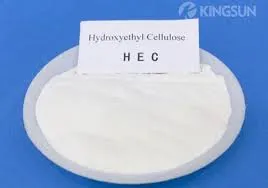
Nov . 07, 2024 06:59 Back to list
Exploring the Properties and Uses of Hydroxyethyl Cellulose in Various Applications
Methyl Hydroxyethyl Cellulose Properties, Applications, and Benefits
Methyl Hydroxyethyl Cellulose (MHEC) is a non-ionic cellulose ether that is widely used in various industries due to its unique properties and versatility. Derived from natural cellulose, MHEC is synthesized through the modification of cellulose with methyl and hydroxyethyl groups. This modification enhances the water solubility and thickening capabilities of cellulose, making MHEC an invaluable additive in many applications.
Properties of Methyl Hydroxyethyl Cellulose
MHEC exhibits several notable properties that contribute to its popularity. One of its most significant characteristics is its ability to form thick, viscous solutions when dissolved in water. This property is particularly useful in applications where viscosity control is essential. MHEC solutions exhibit pseudoplastic behavior, meaning that their viscosity decreases under shear stress, allowing them to flow easily during application but regain thickness upon standing.
Another important property of MHEC is its exceptional water retention capability. This characteristic is beneficial in construction and building materials, where it helps maintain moisture levels, thus enhancing the hydration of cement and ensuring better bonding and durability. Additionally, MHEC is chemically stable and resistant to salt and temperature variations, making it suitable for diverse environmental conditions.
Applications of Methyl Hydroxyethyl Cellulose
MHEC is utilized in a myriad of industries, each benefitting from its unique properties. One of the most prominent applications is in the construction industry. It is extensively used as a thickening and water-retaining agent in mortars, plasters, and tile adhesives. The use of MHEC in these applications not only improves workability but also extends the open time, allowing for better alignment and adjustment of tiles before the adhesive sets.
In the pharmaceutical industry, MHEC acts as a binder, emulsifier, and stabilizer in various formulations. Its ability to form films provides controlled release properties for active ingredients, thus enhancing the efficacy of medications. Furthermore, MHEC is used in cosmetics and personal care products as a thickener and stabilizer, providing a smooth texture and improving the application experience.
methyl hydroxyethyl cellulose

The food industry also harnesses the potential of MHEC, where it serves as a thickening and stabilizing agent in a variety of products, including sauces, dressings, and dairy products. Its usage allows for improved mouthfeel and viscosity control, which are crucial in delivering high-quality food products.
Benefits of Using Methyl Hydroxyethyl Cellulose
The incorporation of MHEC into formulations offers numerous benefits. Its availability in various grades provides flexibility in formulation design, allowing manufacturers to select the right type based on desired viscosity and water retention properties. This adaptability makes MHEC a preferred choice in many applications ranging from heavy-duty construction materials to delicate cosmetic formulations.
Another significant advantage of MHEC is its compatibility with a wide range of other ingredients. It can be easily combined with other additives, allowing for enhanced formulations without compromising functionality. Additionally, being derived from natural cellulose, MHEC is considered safe for use in food and personal care applications, meeting the regulatory requirements of various health authorities.
In terms of environmental considerations, MHEC is biodegradable, making it a sustainable choice compared to some synthetic thickening agents. As industries continue to seek eco-friendly alternatives, MHEC's natural origins and breakdown properties align well with these goals.
Conclusion
Methyl Hydroxyethyl Cellulose is a remarkable cellulose derivative that finds extensive use across diverse fields due to its thickening, stabilizing, and water-retention properties. Whether enhancing construction materials, improving pharmaceutical formulations, or ensuring quality in food products, MHEC stands out as a versatile and beneficial additive. Its natural origin, safety, and environmental compatibility further solidify its role as a preferred choice for manufacturers committed to quality and sustainability. As research and development in cellulose derivatives advance, it is likely that the applications and benefits of MHEC will continue to expand, promoting innovation across industries.
-
Versatile Hpmc Uses in Different Industries
NewsJun.19,2025
-
Redispersible Powder's Role in Enhancing Durability of Construction Products
NewsJun.19,2025
-
Hydroxyethyl Cellulose Applications Driving Green Industrial Processes
NewsJun.19,2025
-
Exploring Different Redispersible Polymer Powder
NewsJun.19,2025
-
Choosing the Right Mortar Bonding Agent
NewsJun.19,2025
-
Applications and Significance of China Hpmc in Modern Industries
NewsJun.19,2025







